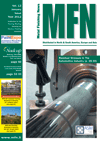E-Archive
Shot Peening in the Automotive Industry
in Vol. 13 - January Issue - Year 2012
Shot Peening For Endurance, Not Only For Strength

Mario Guagliano
When we think about shot peening, we generally think about the media, the induced residual stresses and, finally, we think about the effect of shot peening on the target part in terms of improvement of the fatigue limit. That is to say, that we have in mind the S-N curve of the material and we know that the horizontal part of the diagram is increased by shot peening. The increment can be really pronounced, at least if the parameters are correctly selected and if a proper experimentation accompanies the development of the process. But we know that the S-N curve presents also a leaning part, the so-called finite life region, that refers to the applied stress amplitudes that cause failure after a certain number of cycle, depending on the value of the applied stress. Also in this part of the diagram, the application of shot peening induces a benefit, because the number of cycles that causes failure increases with the application of shot. However, the increment is less marked when the intensity of the applied stress is higher.
This is mainly because the residual stress caused by shot peening tends to relax with high applied stresses. In fact, the sum of the applied and the residual stress causes the localized yielding of the material: the consequence is that the original residual stress in-depth profile will be modified and lower values will be active after a few cycles. This is also the reason why shot peening is less effective when applied to steels with a lower strength, because relevant stress relaxation is possible even for applied stresses not far from the fatigue limit of the material.
Nevertheless, we know that in cars, there are structural parts and/or machine elements that are subjected to a limited number or cycles during their expected life span. And we also know that there are particular cars, namely race cars, that have a lot a components that are substituted after a very limited number of kilometres, since the first requisite of the car is lightness (no matter the costs, the goal is to win the race!). Furthermore, there are parts made with materials with relatively low strength, where appreciable stress relaxation is expected after the application of the fatigue cycles.
In all these cases, the positive effect of shot peening on the fatigue behaviour is generally underestimated or not considered. But is it not possible to think about a shot peening treatment able to work under these circumstances? Is it possible to define a correct shot peening treatment for increasing the number of cycles that cause fatigue failure and not only to increase the fatigue limit?
To answer this question, it is necessary to recall that residual stresses are not the only effect caused by shot peening: surface work hardening is expected and an increment of the surface roughness will also be obtained. As regards this last effect (the roughness) it is not a beneficial effect, since it is well known that the higher the roughness, the lower the fatigue limit. But it is also true that roughness becomes less important if the part is loaded in the finite life portion of the S-N diagram. Surface work hardening is modified by the application of high amplitude fatigue cycles, but experimental studies show that this effect is less pronounced than residual stress relaxation.
By summarizing, residual stresses, surface work hardening and roughness are the main effects induced by shot peening in the target material: all them play a role in the finite life fatigue behaviour. Roughness is not modified by the application of the fatigue cycles, while residual stresses and surface hardening will change during the fatigue cycles, even if residual stress modification will be more pronounced.
Why not study and define a shot peening treatment aimed at improving the fatigue behaviour of mechanical parts subjected to a limited number of cycles during their operative life?
Today, our knowledge and tools to determine with good approximation the dependency of the effect of shot peening as a function of the treatment parameters are adequate. Finite element simulations allow us to estimate the residual stress and surface hardening induced by shot peening and their modification after the application of fatigue cycles. In addition, taking these factors into account, reliable fatigue criteria to assess the fatigue life can be applied.
That is to say, we would be able to assess the effect of shot peening in the finite life region of the S-N diagram with a reduced experimental effort (and reduced costs): could it be a challenge for the near future?
Shot Peening in the Automotive Industry
by Mario Guagliano
Contributing Editor MFN and
Associate Professor of Technical University of Milan
20156 Milan, Italy
E-mail: mario@mfn.li
Author: Mario Guagliano




























